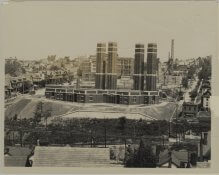
The construction of the Liberty Tunnels in Pittsburgh marked a significant engineering feat in the city’s history, aimed at addressing the growing transportation needs for automobiles in the early 20th century. The tunnels were one of the earliest vehicular tunnels in the Eastern United States, projected to alleviate traffic congestion and provide efficient passage between the South Hills and Downtown Pittsburgh.
Construction of the Liberty Tunnels commenced with a groundbreaking ceremony in December 1919 led by contractor Booth & Flinn Ltd. The tunnels were designed and supervised by Almos D. Neeld, an engineer who lived in Pittsburgh.
About Almos D. Neeld

Almos Davidson Neeld was born in 1858 in West Liberty Borough, now known as Brookline. He was the youngest graduate at the University of Pittsburgh Engineering school in 1875 at age 17. His engineering career began around 1885 with the Pennsylvania & Lake Erie Railroad. He continued working for railroads through the late 1800’s, and completed projects around Pittsburgh before working on the Liberty Tunnels in 1919. One Pittsburgh project included the design and construction of the County Highway Tunnel No. 1, which would have run from East Carson and South Third Streets to Warrington Avenue near Boggs Avenue. Construction began in 1915, but objections raised by citizens led to a Supreme Court ruling that the county had no authority to build tunnels, thus ending the project. You can learn more about Neeld and his work in the exhibit.
The Carbon Monoxide Incident

The tunnels opened to the public in early 1924, however its ventilation system was not fully operational. In May 1924, the amount of traffic led to a buildup of carbon monoxide, causing several travelers to lose consciousness while stuck in traffic. After the incident, traffic was regulated until the ventilation system was completely installed.
The U.S. Bureau of Mines worked along A.D. Neeld and tunnel engineers to build a ventilation plant that could support high traffic flows in the tunnels. In 1928, a ventilation plant was completed on Mount Washington, featuring large fans and exhausts to pump fresh air through the shafts and tunnels.

Liberty Bridge and the Tunnels Today
The Liberty Bridge was completed and connected to the tunnels in March, 1928. It connected the South Hills to Downtown Pittsburgh. Today we celebrate the “Liberty Tubes” 100th anniversary with an exhibit that shares artifacts, photographs, building and business records, blueprints and more from the Liberty Tunnels Collection, held in Carnegie Library of Pittsburgh’s Archives.
The exhibit will be up throughout the Spring of 2024, and is viewable on the second floor of CLP-Main. The collection comes from the files of Chief Engineer, Almos D. Neeld, and presents a view of tunnel construction from 1919 to 1923. The collection also highlights the building of the ventilation plant completed in 1928.


The Liberty Tunnels Collection has progress reports, construction records, business records, correspondence, blueprints, photographs, and more. It also contains engineering resources kept by Neeld regarding tunnels, concrete, steel and sewers. Neeld may have been inspired by other tunnels on the East Coast, which you can find highlighted in this exhibit. Also on display are headlines and newspaper clippings highlighting construction and other happenings in the “Liberty Tubes.”
In celebration of the 100th anniversary, we encourage you to help us answer every Yinzer’s question approaching a tunnel during rush hour: “Why does traffic always slow down before the tunnel?”
Additional Resources
Despite our lengthy commutes each day and night, Pittsburghers love our tunnels. Here are a few resources to learn more about the tunnels:
- “A First Glimpse through the Liberty Tubes,” Heinz History Center
- “Once Upon a Tunnel,” by Tom Imerito, Pittsburgh Quarterly, 2016
- “The Liberty Tunnels and Bridge: Gateway to the South Hills,” Brookline Connection
The finding aid for the Liberty Tunnels Collection will be up soon on historicpittsburgh.org.
For more information
call: 412-622-3114
email: info@carnegielibrary.org
library chat: carnegielibrary.org.


